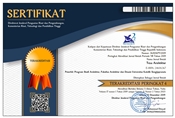Pemanfaatan Area Pekarangan Sebagai Lanskap Produktif di Permukiman Perkotaan
Abstract
Keywords
Full Text:
PDFReferences
Arifin, H. S. 2012. Manajemen Lanskap Pekarangan Bagi Ketahanan Pangan Keluarga.Pangan Rakyat: Soal Hidup atau Mati 60 Tahun Kemudian. PERHEPI.
Bohn K., Viljoen A., 2002. TheEdible City: Envisioningthe Continuous. Productive UrbanLandscape (CPUL),http://www.field-journal.com
GanDe-xin,Luo Jun, Chen Qiong-lin,LongYue-lin, 2010. FunctionandUtilization ofProductive Landscape inUrbanLandscape Development, Journal of HumanAgriculturalUniversity(NaturalScience), Issue S2; 1007-1032.
Daniels,G.D., Kirkpatrick, J.B., 2006, Comparing the Characteristics of Front and Back Domestic Gardens in Hobart, Tasmania, Australia, Landscape and Urban Planning 78 (2006); 344–352
Setyawan, B..,Rahmi,D.W,2004.KetahananPangan,LapanganKerjadanKeberlanjutanKota:StudiPertanianKotadiEnamKotaIndonesia.Warta Penelitian, Edisi Khusus; 34 - 42,Pusat StudiLingkunganHidup. Yogyakarta: Universitas Gadjah Mada.
DOI: https://doi.org/10.24167/tesa.v16i1.1213
ISSN 1410-6094 (Print) | ISSN 2460-6367 (Media Online) | View My Stats

This work is licensed under a Creative Commons Attribution 4.0 International License.








